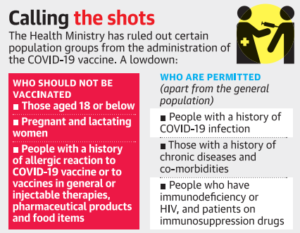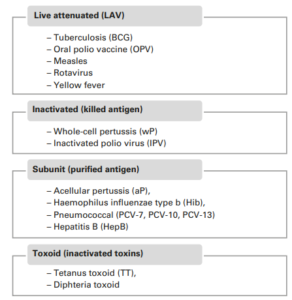In news : The world’s largest vaccination drive begin on 16 January in India
About the Vaccination programme
- The world’s largest vaccination programme will begin at a total of 3006 session sites across all States/UTs, which will be connected virtually throughout the exercise.
- Approximately, 100 beneficiaries will be vaccinated at each of the session sites.
- As per PMO’s release, a dedicated 24×7 call centre 1075 has also been established for addressing the queries related to the pandemic, vaccine rollout and the CoWIN software
- The vaccination drive, where the beneficiaries currently will not have a choice between the two vaccines Covishield and Covaxin available in India, has been planned in a phased manner, identifying priority groups

- As per the Health Ministry, Healthcare workers, both in the government and private sectors including Integrated Child Development Services (ICDS) workers, will receive the vaccine during this first phase.
- CoWIN, the online digital platform has been developed by the Ministry to be used to drive the vaccination programme.
- The platform will facilitate real time information of vaccine stocks, storage temperature and individualized tracking of beneficiaries for Covid-19 Vaccine
- According to the Health Ministry, CoWIN platform will assist programme managers across National, State, and District levels while conducting vaccination sessions.
- It will help them track beneficiary coverage, beneficiary dropouts, sessions planned v/s sessions held and vaccine utilization
- It added that the platform enables national and state administrators to view and sort data of beneficiaries as per their gender, age and co-morbidity.
Do you know?
What is a Vaccine
A vaccine is a biological preparation that provides active acquired immunity to a particular infectious disease. A vaccine typically contains an agent that resembles a disease-causing microorganism and is often made from weakened or killed forms
What is vaccination?
- Vaccination is a simple, safe, and effective way of protecting people against harmful diseases, before they come into contact with them. It uses your body’s natural defenses to build resistance to specific infections and makes your immune system stronger.
- Vaccines train your immune system to create antibodies, just as it does when it’s exposed to a disease.
- However, because vaccines contain only killed or weakened forms of germs like viruses or bacteria, they do not cause the disease or put you at risk of its complications.
- Most vaccines are given by an injection, but some are given orally (by mouth) or sprayed into the nose.
How does a vaccine work?
Vaccines reduce risks of getting a disease by working with your body’s natural defenses to build protection. When you get a vaccine, your immune system responds. It:
- Recognizes the invading germ, such as the virus or bacteria.
- Produces antibodies. Antibodies are proteins produced naturally by the immune system to fight disease.
- Remembers the disease and how to fight it. If you are then exposed to the germ in the future, your immune system can quickly destroy it before you become unwell.
Our immune systems are designed to remember. Once exposed to one or more doses of a vaccine, we typically remain protected against a disease for years, decades or even a lifetime. This is what makes vaccines so effective. Rather than treating a disease after it occurs, vaccines prevent us in the first instance from getting sick.
The vaccine is therefore a safe and clever way to produce an immune response in the body, without causing illness.
Different types of vaccine
There are many types of vaccines, categorized by the antigen used in their preparation. Their formulations affect how they are used, how they are stored, and how they are administered. The globally recommended vaccines discussed in this module fall into four main types.

Mono and polyvalent vaccines:
Vaccines may be monovalent or polyvalent. A monovalent vaccine contains a single strain of a single antigen (e.g. Measles vaccine), whereas a polyvalent vaccine contains two or more strains/serotypes of the same antigen (e.g. OPV).
Combination vaccines :
Some of the antigens above can be combined in a single injection that can prevent different diseases or that protect against multiple strains of infectious agents causing the same disease (e.g. combination vaccine DPT combining diphtheria, pertussis and tetanus antigens). Combination vaccines can be useful to overcome logistic constraints of multiple injections, and accommodate for a children’s fear of needles and pain.
Live attenuated vaccines:
Available since the 1950s, live attenuated vaccines (LAV) are derived from disease- causing pathogens (virus or bacteria) that have been weakened under laboratory conditions. They will grow in a vaccinated individual, but because they are weak, they will cause no or very mild disease
Inactivated whole-cell vaccines:
Inactivated vaccines are made from microorganisms (viruses, bacteria, other) that have been killed through physical or chemical processes. These killed organisms cannot cause disease.
Submit Vaccines:
Subunit vaccines, like inactivated whole-cell vaccines do not contain live components of the pathogen. They differ from inactivated whole-cell vaccines, by containing only the antigenic parts of the pathogen. These parts are necessary to elicit a protective immune response
















